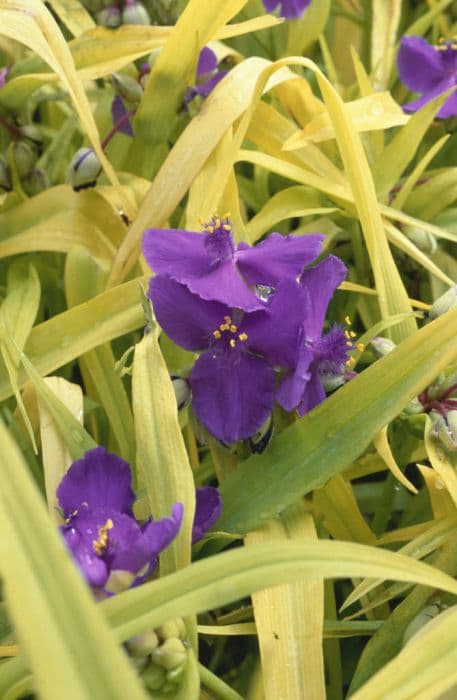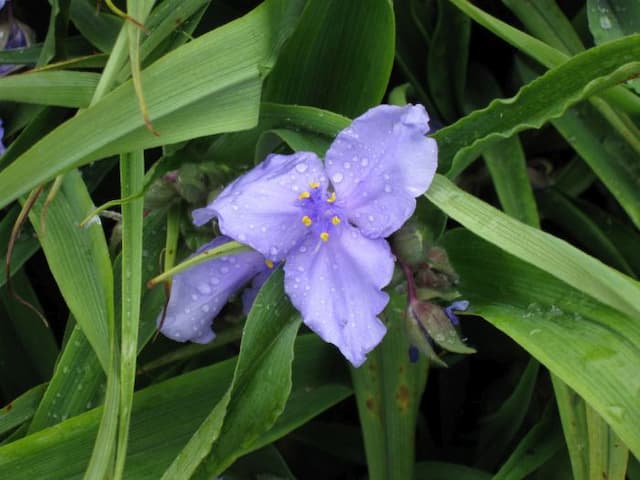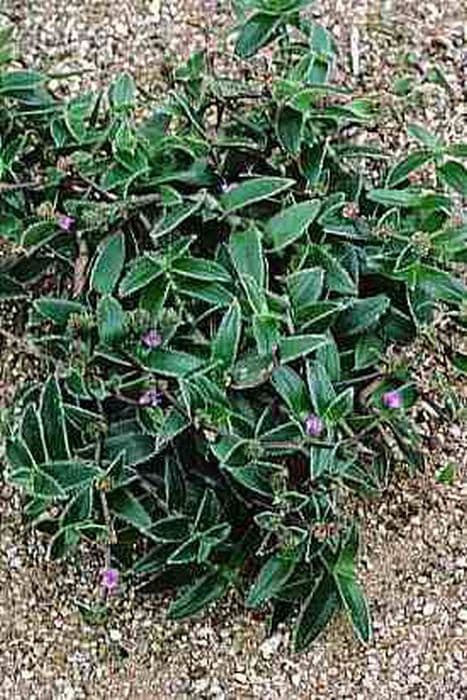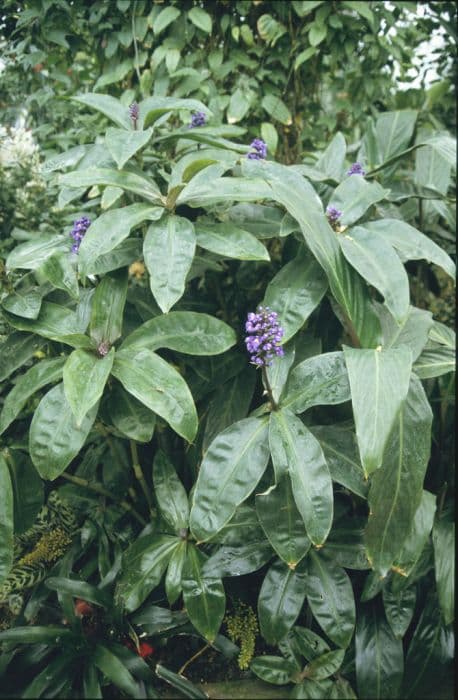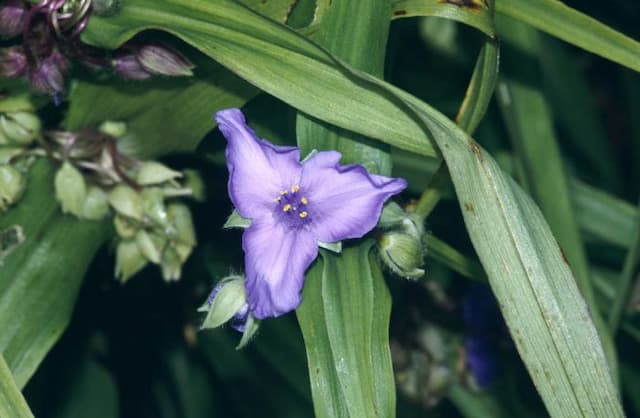White Velvet Tradescantia sillamontana

ABOUT
The plant known as the White Velvet or White Gossamer plant is acknowledged for its striking appearance. It has fleshy, elongated leaves that have the texture of soft velvet due to a dense covering of white hairs. This gives the leaves a silvery or white appearance, which contrasts beautifully with the plant's green undercoat. The White Velvet plant often has leaves that are arranged neatly in a rosette pattern, contributing to its compact and attractive look. In this plant, the white hairs serve a purpose beyond aesthetics; they help to reduce moisture loss by trapping a layer of air close to the leaf surface, acting as insulation against high temperatures. When it blooms, the plant produces small, three-petaled flowers that are typically a vivid shade of magenta or purple, adding an extra splash of color against the muted tones of the foliage. These blossoms are typically nestled within the upper leaf axils and can offer a charming display of color. The overall impression of the White Velvet plant is one of a soft, tactile nature, with a sophisticated palette of silvery whites and greens accented by the vibrant blooms. Its distinctive, hairy foliage sets it apart from other plants, making it a unique specimen in any plant collection.
About this plant
 Names
NamesFamily
Commelinaceae
Synonyms
White Velvet, White Gossamer Plant, Cobweb Spiderwort, Hairy Wandering Jew
Common names
Campelia sillamontana, Rhoeo sillamontana, Setcreasea sillamontana, Tradescantia pexata, Tradescantia pexata subsp. sillamontanoides.
 Toxicity
ToxicityTo humans
The White Velvet or Cobweb Spiderwort is generally considered non-toxic to humans. While it may cause mild irritation or an allergic reaction in some individuals if they handle the plant and then touch their eyes or sensitive skin, ingesting it is not known to cause poisoning. Therefore, there are no specific symptoms of poisoning associated with this plant, as it is not regarded as poisonous.
To pets
White Velvet or Cobweb Spiderwort is also considered non-toxic to pets. This means that if pets, such as dogs or cats, ingest parts of the plant, they are unlikely to suffer from poisoning. However, as with humans, some pets might experience mild gastrointestinal upset or an allergic reaction if they are sensitive to the plant. No severe toxicity or life-threatening symptoms are typically expected from ingestion.
 Characteristics
CharacteristicsLife cycle
Perennials
Foliage type
Evergreen
Color of leaves
Green
Flower color
Pink
Height
1 foot 0.3 meters
Spread
1 foot 0.3 meters
Plant type
Succulent
Hardiness zones
7
Native area
Mexico
Benefits
 General Benefits
General Benefits- Low Maintenance: Tradescantia sillamontana, commonly known as White Velvet or Cobweb Spiderwort, is a low-maintenance plant that requires minimal care, making it suitable for beginners.
- Drought Tolerant: It is highly drought-tolerant, allowing it to survive in dry conditions with less frequent watering.
- Tolerates Neglect: This hardy plant can tolerate neglect, thriving even when caretaking isn't consistent.
- Unique Aesthetic: Its distinctive fuzzy, silver-green leaves with cobweb-like hairs provide a unique textural element to any garden or indoor space.
- Fast Growing: White Velvet grows quickly, which can be rewarding for gardeners looking to see rapid progress in their plants.
- Easy Propagation: It can be easily propagated through stem cuttings, making it simple to create more plants for different areas or to share with friends.
- Adaptable: This plant adapts well to both indoor and outdoor environments as long as it is protected from extreme temperatures.
- Ground Cover: White Velvet can be used as an attractive and unusual ground cover in suitable climates, spreading to cover bare areas.
 Medical Properties
Medical PropertiesThis plant is not used for medical purposes.
 Air-purifying Qualities
Air-purifying QualitiesThis plant is not specifically known for air purifying qualities.
 Other Uses
Other Uses- White Velvet as a natural dye: The sap of the White Velvet plant can sometimes be used to produce a subtle range of colors for natural fabric dyes.
- Crafts and flower arrangements: White Velvet's distinctive fuzzy foliage can be incorporated into dried flower arrangements or used to add texture to crafts.
- Photography subjects: With their unique appearance, White Velvet plants offer an interesting subject for photographers, especially those specializing in macro photography.
- Education and research: White Velvet can be used in schools or biological studies to teach about plant adaptations, such as its fuzzy leaves which aid in drought resistance.
- Textile pattern inspiration: The striking patterns of White Velvet leaves can inspire designs for textiles, wallpapers, or other decorative prints.
- Aesthetic enhancement for terrariums: Due to its low maintenance and interesting texture, White Velvet can be a great addition to terrariums with a focus on aesthetic appeal.
- Theme gardens: The White Velvet plant can contribute to the specific aesthetics of themed gardens, such as 'xeriscapes' or 'fuzzy gardens,' that celebrate unique plant characteristics.
- Study of plant propagation: White Velvet is easy to propagate from cuttings, making it useful for demonstrations or experiments related to plant reproduction.
- Jewelry making: Dried pieces of White Velvet can be incorporated into homemade jewelry, like pendants or brooches, for a natural, bohemian look.
- Color and texture contrast in garden design: The silvery foliage of White Velvet can be used in garden design to create contrast against darker green plants or brightly colored flowers.
Interesting Facts
 Feng Shui
Feng ShuiThe White Velvet is not used in Feng Shui practice.
 Zodiac Sign Compitability
Zodiac Sign CompitabilityThe White Velvet is not used in astrology practice.
 Plant Symbolism
Plant Symbolism- Adaptability: Tradescantia sillamontana, commonly known as White Velvet, has the ability to thrive in various light conditions which symbolizes adaptability to life’s changing circumstances.
- Resilience: White Velvet is known for its toughness and can survive in drought-like conditions, making it a symbol for persistence and the ability to bounce back.
- Growth: As White Velvet can grow quickly and spread, it symbolizes personal growth and the capacity to move forward from difficulties.
- Protection: The thick, silvery hairs on the leaves of White Velvet serve as a protective layer for the plant, representing shelter and safety in a symbolic sense.
 Water
WaterThe White Velvet, also known as Tradescantia sillamontana, should be watered when the top inch of soil feels dry to the touch. Typically, this may mean watering approximately once a week, but the frequency will depend on environmental conditions such as temperature and humidity. Use room temperature water, and ensure that you provide enough water to moisten the soil thoroughly until it just begins to drain from the bottom of the pot—this could be around 8 to 16 ounces for a smaller pot. Overwatering can lead to root rot, so it's crucial to let the soil dry out between waterings.
 Light
LightThe White Velvet prefers bright, indirect light to thrive. Place it in a spot where it will receive plenty of light but is shielded from the direct rays of the sun, such as near an east- or north-facing window. Direct sunlight can scorch its leaves, while too little light can cause leggy growth and less vibrant foliage.
 Temperature
TemperatureWhite Velvet plants are best kept in temperatures between 60 and 80 degrees Fahrenheit, which is ideal for most indoor environments. They can withstand short periods of cooler weather, but should not be exposed to temperatures below 50 degrees Fahrenheit, as cold temperatures can cause damage to the plant. It's best to avoid placing your plant near drafts, heating vents, or air conditioners to maintain consistent temperature conditions.
 Pruning
PruningPruning White Velvet helps to encourage bushier growth and maintain an attractive shape. Trim back leggy stems or any yellowing leaves using clean, sharp scissors. The best time for pruning is in the spring or early summer, which will also give the plant time to recover and produce new growth throughout the season. Pruning can be done as needed, but avoid over-pruning, as this can stress the plant.
 Cleaning
CleaningAs needed
 Soil
SoilWhite Velvet prefers a well-draining soil mix with a pH between 6.0 and 7.0. A mixture of potting soil, perlite, and coarse sand is ideal to ensure proper drainage and aeration, mimicking its native environment.
 Repotting
RepottingWhite Velvet should typically be repotted every 1-2 years or when it outgrows its current pot to ensure adequate room for root growth and prevent nutrient depletion in the soil.
 Humidity & Misting
Humidity & MistingWhite Velvet thrives in moderate to high humidity levels, ideally between 40% and 70%. It can tolerate lower humidity but will benefit from occasional misting or a humidifier nearby.
 Suitable locations
Suitable locationsIndoor
Place in bright, indirect light and keep soil slightly moist.
Outdoor
Needs partial shade or morning sun and protection from harsh elements.
Hardiness zone
7-10 USDA
 Life cycle
Life cycleTradescantia sillamontana, also known as White Velvet or Cobweb Spiderwort, begins its life as a seed, requiring warm temperatures and well-draining soil to germinate. Upon sprouting, the seedlings grow into juvenile plants with distinctive silvery, hairy leaves as they undergo vegetative growth, establishing a root system and foliage. During its mature stage, the plant reaches its full size and produces small, three-petaled magenta or purple flowers, typically in the warmer months. After flowering, pollination occurs, leading to the production of seeds, allowing for the continuation of the plant's life cycle. In suitable conditions, this perennial plant can also propagate vegetatively through stem cuttings or division, which contributes to the spread of the plant within its habitat. The White Velvet naturally goes into a period of dormancy during colder months, reducing growth until favorable conditions return.
 Propogation
PropogationPropogation time
Spring-Early Summer
Tradescantia sillamontana, commonly known as the White Velvet or Cobweb Spiderwort, is frequently propagated through the division of rooted plantlets or by stem cuttings. The ideal time to propagate is in the spring or early summer when the plant is actively growing. To propagate using stem cuttings, a healthy stem segment of about 4 to 6 inches (10 to 15 centimeters) should be cut just below a node, and the lower leaves removed. The cutting can then be placed directly into moist potting soil or first dipped into rooting hormone powder to encourage root growth. It's important to keep the soil consistently moist but not waterlogged and to place the cutting in bright, indirect light until new growth indicates that the cutting has rooted successfully, which typically takes a few weeks.

